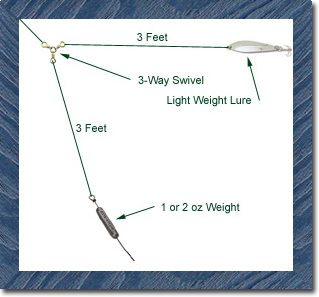Brook Trout are the most sought after species of trout in Ontario and they can be very elusive. Just the tiniest change in weather can make them stop feeding for days. If you have had a few days or sunny high-pressure weather without any micro-storms or other atmospheric anomalies, then it's the perfect time to go Brook Trout fishing.
Around Murray Lake are a few nice Brook Trout streams and Brook Trout Lakes. Brook Trout in the lakes tend to get much larger but to Brook Trout fanatics the stream fish are more desirable because they feed almost exclusively on insects and have that dark red meat that just taste out of this world.
Lake Fishing with Lures:
In the small spring-fed in the spring you can cast tiny spoons and spinners such as Little Cleos, Mepps Cyclops, Fox Blue Spinners, Vibrex Spinners and just the regular Mepps spinners. There are well known brand names. There are many small spinners on the market that work well. The Brook Trout will be right close to the surface, especially in the evening. In the spring the Brook Trout like to stay close to structure whether it's big rocks in the water or fallen trees along the shore. If there are Brook Trout in the lake that means the water is crystal clear so be very quiet, move slowly and don't wear any bright colored clothing. Try to dress in natural colors like browns and dark greens. It's also best to use 4-pound test line in a low visibility dark green. Just make sure your drag is set for 4 pound test.
In the spring you can hit the Brookies with flies. Fly-fishing is a traditional way to catch them and on some days can be very effective. In the spring you need to use bigger dry-flies that mimic May Flies. You want to cast out where you see rippled or a disturbance on the surface but don't pull the fly towards you. May flies do not skim across the surface at that time of year all the trout are focusing on is May Flies. They flip-flop around trying to escape their exoskeleton and dry their wings, not skim around like other water bugs. The best thing to do is cast out and then spin your rod in your hands until the fly starts to flip-flop. You may have to use a heavier lead line to get the fly to flip.
In the summer later in the evening try casting dry flies where you see ripples or movement close to the water. Don't pull the line fast like you would for Rainbow Trout. Let the fly sit on the surface and every 5 to 10 seconds bring the fly a foot closer. Another trick is to use a wet fly with a regular fishing rod. About 4 feet from the end of the line you want a wood floater. What many people do is cut a half-inch section off a broom handle and then drill a small hole through it. Slide it up the line before you tie your fly on. Then use a spit-shot to keep the piece of wood 4 feet from your wet fly. This way you can cast a long distance and you can let your wet-fly drop down 4 feet and then pull the line to let the fly come to the surface and then let it sink again. This is a good technique for when the trout are shallow but not coming to the surface. In late spring you can set the float so the fly can sink down 6 feet.
|
In the summer by late morning and into the middle of the day the Brook Trout will go deeper. If it's a Brook Trout Lake that means the water is 53 degrees at or above the 35-foot depth level. Brook Trout do not like to go deeper than 35 feet at any time. With this in mind it's best to troll very slowly with a 3-wat swivel rig. You want to use tiny flutter lures like small Williams Wabblers, Sutton Silver Spoons or other light flutter spoons.
|

|
A 1 to 1.5 inch spoon is more that big enough. You don't want to use Lake Trout spoons. With a 3-way swivel rig, 4-pound test and a 1-oz weight you can easily troll 35 feet deep. You want to only troll fast enough for the lure to work.
Stream Fishing for Brook Trout:
Casting tiny spoons and spinners will work in big pools and in places where there is not an excessive amount of overhanging bush but not practical for most parts of the smaller streams found in the area. The very best bait is a tiny hook and split-shot with a small piece of worm. When fishing a stream always walk up stream so the hole you are about to fish is not disturbed with settlement that you have kicked up. The Brook Trout will hide in the back of deep pool, under logs and tree roots and in the watercress. You want cast above where you think a trout might be hiding and let the bait flow with the water. Some log jams will be situated that you have to drop you bait from up stream. In this case walk through the bush and avoid stepping in the water. It's also imperative that you dress in black, dark green or dark brown. Camouflage gear also works. You can't see them but they can see you. Avoid getting bug spray on your hands and always wet your hands before touching a Brook Trout. Picking up a Brook Trout with dry hands and then letting them go will result in a high mortality rate. A dry hand will rub off the protective layer of slime and leave the fish extremely vulnerable to skin infection and deadly parasites.
Main Brook Trout Fishing Page
Brook Trout Photo Galleries
Lake Maps
Brook Trout Fishing Regulations





